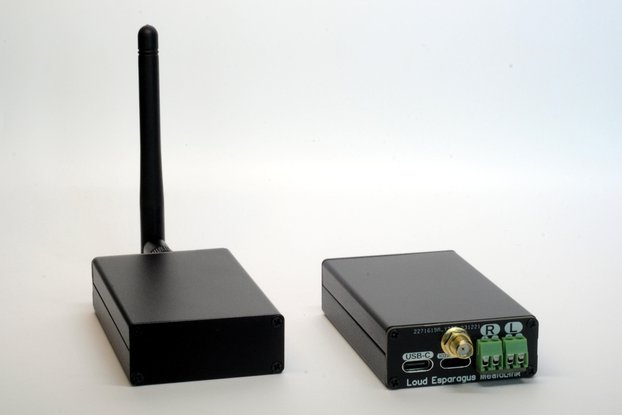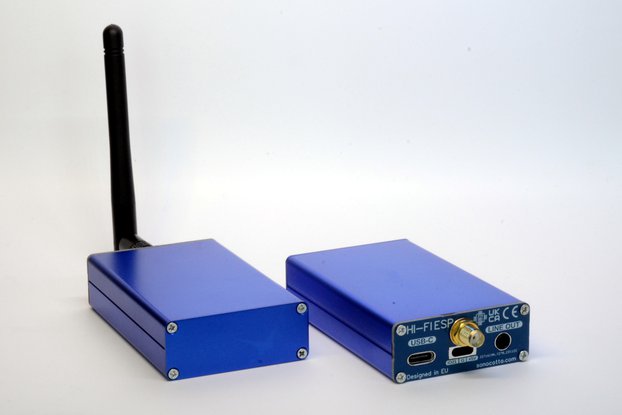Home Media Center powered by Raspberry Pi and TAS5805M DAC
Designed by Sonocotta in Poland
Buy with confidence.
Our Tindie Guarantee protects your purchase from fraud. Learn More
What is it? The Raspberry Pi Home Media Center is a compact and neatly designed hardware project that combines the power of the Raspberry Pi Zero board and the Hi-Fi audio capabilities of the TI’s TA…
Read More…The Raspberry Pi Home Media Center is a compact and neatly designed hardware project that combines the power of the Raspberry Pi Zero board and the Hi-Fi audio capabilities of the TI’s TAS5805M DAC with a highly efficient D-Class output stage. This versatile media center provides a customizable and fully open-source hardware platform for home entertainment.
| Louder Raspberry Pi | Louder Raspberry Pi NOPD |
|---|---|
With a minimalistic but functional design inspired by commercial audio gear, it offers a seamless user experience. It aimed to support Volumio, Mopidy, or any custom firmware you may come up with.
I did a few audio projects in the past, some using ESP32, some using larger Orange Pi and Raspberry Pi devices. Each has its pros and cons, and in each iteration, I'm trying to focus on the details that were working best for me while actually using them.
What is special about the Raspberry ecosystem is, of course, its community support. Being a not-so-strong software developer, I often have to rely on the work that other people did and baked into the base Raspbian image. Enabling the Ethernet and IR reader is as simple as adding 2 lines into config.txt file. Adding DAC is a 5-minute job (with attached code). All the device tree definitions, kernel drivers, and dependency packages are already in place, believe it or not.
Sure, compared to the ESP32 platform, it is not as lightweight. It requires more power, it takes some time to boot. But when it comes to rapid development, there is nothing like the Raspberry Pi.
Louder Raspberry Pi is a top-of-the-range model that uses a modern, highly capable TAS5805M DAC and is aimed to be paired with medium-to-large speaker systems. With 25W per channel stereo output, it packs a punch and can easily enliven living quarters or dorm rooms. It is highly efficient but much more demanding for power when cranked, therefore, it uses USB-C Power Delivery to pull up to 65W from the wall power adapter. It can be used both with Wi-Fi and Ethernet (to make sure bad Wi-Fi would not interrupt the stream)
| HiFi Raspberry Media Center and Hat | Amped Raspberry Media Center and Hat | Loud Raspberry Media Center and Hat | Louder Raspberry Media Center and Hat | |
|---|---|---|---|---|
| Image (Media Center) | ||||
| Compatible with (Media Center) | Raspberry Pi Zero (W), Raspberry Pi Zero2 W | Raspberry Pi Zero (W), Raspberry Pi Zero2 W | Raspberry Pi Zero (W), Raspberry Pi Zero2 W | Raspberry Pi Zero (W), Raspberry Pi Zero2 W |
| Image (Hat) | ||||
| Compatible with (1X Hat) | Every Pi | Every Pi | Every Pi | Every Pi |
| Image (Hat, 2X) | ||||
| Compatible with (2X Hat) | Raspberry Pi 5 | Raspberry Pi 5 | Raspberry Pi 5 | Raspberry Pi 5 |
| DAC | Single PCM5100A 32bit Stereo DAC | Single (1X) or Dual (2X) PCM5100A 32bit Stereo DAC working with TPA3110D2 D-Class amp | Dual (1X) or Quadruple (2X) I2S DAC MAX98357 with built in D-Class amp | (1X) Stereo I2S DAC TAS5805M with built in D-Class amp(2X) Dual (2.1) I2S DAC TAS5805M with built in D-Class amp |
| Output | 2.1 VRMS Line level output -100 dB typical noise level | [1X]2x 25W (8Ω, 1% THD+N) at 22V; 2x 22W (4Ω, 1% THD+N) at 16V 1x 40W (4Ω, 1% THD+N) at 20V[2X]4x 25W (8Ω, 1% THD+N) at 22V; 4x 22W (4Ω, 1% THD+N) at 16V 2x 40W (4Ω, 1% THD+N) at 20V | [1X] 2x 3W (8Ω); 2x 5W (4Ω) [2X] 4x 3W (8Ω); 4x 5W (4Ω) | [1X] 2x 22W (8Ω, 1% THD+N); 2x 32W (4Ω, 1% THD+N) at 20V 1x 45W (4Ω, 1% THD+N) at 20V [2X]: 2x 22W (8Ω, 1% THD+N) + 1x 45W (4Ω, 1% THD+N) |
| RGB LED | Media Center only | Media Center only | Media Center only | Media Center only |
| IR input | yes | yes | yes | yes |
| Onboard Serial Bridge | Media Center only | Media Center only | Media Center only | Media Center only |
| Ethernet (Media Center) | Wiznet W5500 SPI Ethernet | Wiznet W5500 SPI Ethernet | Wiznet W5500 SPI Ethernet | Wiznet W5500 SPI Ethernet |
| Powers from | Media Center: 5V USB-C power adapter (up to 1 A)Hat: 5V from the host Internally: LP5907 3.3 V Ultra-Low-Noise LDO | 8..26V from external sourcepowering host (up to 3A cont.) | Media Center: 5V USB-C power adapter (up to 3 A) Hat: 5V from the host (up to 4A) or 5V from screw connector (powering host) | 65W USB-C PD power adapter [NOPD] Up to 26V from external PSU[Hat] 7..28V from external sourcepowering host (up to 3A cont.) |
| Mechanical dimensions (WxHxD), Media Center | 88mm x 38mm x 100mm | 88mm x 38mm x 100mm | 88mm x 38mm x 100mm | 88mm x 38mm x 100mm |
| Mechanical dimensions (WxHxD), Hat | 65mm x 30mm x 15mm | 70mm x 61mm x 20mm | 65mm x 30mm x 20mm | 65mm x 56mm x 20mm |
| I2S CLK | I2S DATA | I2S WS | |
|---|---|---|---|
| Raspberry Pi Zero | 18 | 21 | 19 |
| SPI CLK | SPI MOSI | SPI MISO | LAN RES | LAN CS | LAN INT | WS2812 RGB LED | RELAY EN | IR INPUT | |
|---|---|---|---|---|---|---|---|---|---|
| Raspberry Pi Zero | 11 | 10 | 9 | 24 | 8 | 25 | 12 | 7 | 23 |
| I2C CLK | I2C DATA | DAC PWDN | DAC FAULT | PD POWER GOOD | |
|---|---|---|---|---|---|
| Raspberry Pi Zero (BCM) | 3 | 2 | 4 | 26 | 16 |
You can use any distribution you like. To enable IR reader and Ethernet, you need to add 2 lines to the /boot/config.txt
dtoverlay=gpio-ir,gpio_pin=23
dtoverlay=w5500
TAS5805M DAC is not supported by default Raspbian distribution, therefore, some work needs to be done to enable it. Linked repo contains code and instructions on how to configure it. It will take you 5 minutes and one reboot.
| Front | Back | Back (NOPD) | PCB |
|---|---|---|---|
Please visit the hardware section of the project repo for board schematics and PCB designs. Note that PCBs are shared as multi-layer PDFs as well as Gerber archives.
The Louder Raspberry can be quite a power-hungry device; simply using 5V over the USB-C is clearly not an option. You'd need a PD-enabled power adapter to run the board. Ideally, you should supply a 20V 3.25 Amp capable power source, common for modern laptops (Dell, HP, and Lenovo all tested and work perfectly). However, pretty much any 9V/12V/20V PD-enabled power adapter will work, most typically phone chargers with a quick charge option. The smallest of the family is a 25W model, which is plenty enough for both Raspberry Pi and DAC.
The interesting part was that all the phone and laptop chargers I used for the test (around five different makes of each) sounded great, with no hissing and no popping. (Apart from the Apple ones, they didn’t work. Likely they have Apple-specific PD protocol.) This is probably because modern devices have become so noise-sensitive that manufacturers have been forced to do good work on noise levels.
Tested and perfectly working models are (others may be available)
| Model | Image |
|---|---|
| 65W USB-C Lenovo ThinkPad Laptop Charger Replacement Power Adapter | |
| 65W 45W 20V 3.25A Type-C PD Laptop Charger | |
| 120W Gan Type-C PD Charger | |
| 45W Type-C PD Mobile Phone Wall Adapter |
Because USB-PD is a bit of a Wild West in terms of standards, sometimes, not everything goes as designed. Some people have run into this with power adapters that aren’t fully PD-standard compliant. In most cases, the worst that happens is the PD chip doesn’t trigger the 20V mode, so the Raspberry Pi goes into the boot loop, not getting enough voltage on the 5V bus.
The “hammer-style” solution I came up with is a new NOPD version of the Louder Raspberry that lets you use a barrel power jack to supply raw voltage directly. The catch? Standard 2mm pins can’t handle high currents, so I’ve gone with a 2.5mm pin instead — it’s a bit unusual, but still common enough in the laptop world.
With this setup, you can supply more than the 20V limit of PD, giving you a bit more power for the speakers. You probably won’t hear much difference (thanks to the way human hearing works), but it could help larger speakers that need a bit more to really “open up." Other than that, the NOPD version works just like the PD version — no software changes are needed.
The power adapter specs depend on the speaker you're planning to use. DAC efficiency is close to 100%, so just take the power rating of your speaker (say 2x10w) and impedance (say 8 ohms), and you'd need at least 9 volts rated at 1.2 amps per channel, round up to 3 total amps. Consider Pi itself drawing 5-10W of power when busy.
It is not recommended to go beyond the voltage your speakers can take, otherwise, the amp will blow your speakers in no time.
The absolute maximum voltage for the TAS5805M DAC is 30V, but it is not guaranteed to be thermally stable in this condition.
No country selected, please select your country to see shipping options.
No rates are available for shipping to .
Enter your email address if you'd like to be notified when Louder Raspberry Pi Media Center can be shipped to you:
Thanks! We'll let you know when the seller adds shipping rates for your country.
| Shipping Rate | Tracked | Ships From | First Item | Additional Items |
|---|---|---|---|---|
|
:
|
Most of the packages are sent the next business day in the morning CET time. Delivery time varies wildly, but typically it is 1-2 weeks within EU and 3-4 weeks outside EU due to delays in customs. If the package does not show up after 8 weeks, please reach out for a replacement or refund.
Product: (5.00)
Documentation: (5.00)
Shipping: (5.00)
Communication: (5.00)
James | Nov. 8, 2024
Matthew | July 10, 2024
Buy with confidence.
Our Tindie Guarantee protects your purchase from fraud. Learn More

$21.00
Free Shipping!

$21.00
Free Shipping!

$16.00
Free Shipping!

$69.00
Free Shipping!

$24.00
Free Shipping!

$45.00
Free Shipping!

$21.00
Free Shipping!

$45.00
Free Shipping!
By clicking Register, you confirm that you accept our Terms & Conditions
We recognize our top users by making them a Tindarian. Tindarians have access to secret & unreleased features.
We look for the most active & best members of the Tindie community, and invite them to join. There isn't a selection process or form to fill out. The only way to become a Tindarian is by being a nice & active member of the Tindie community!
